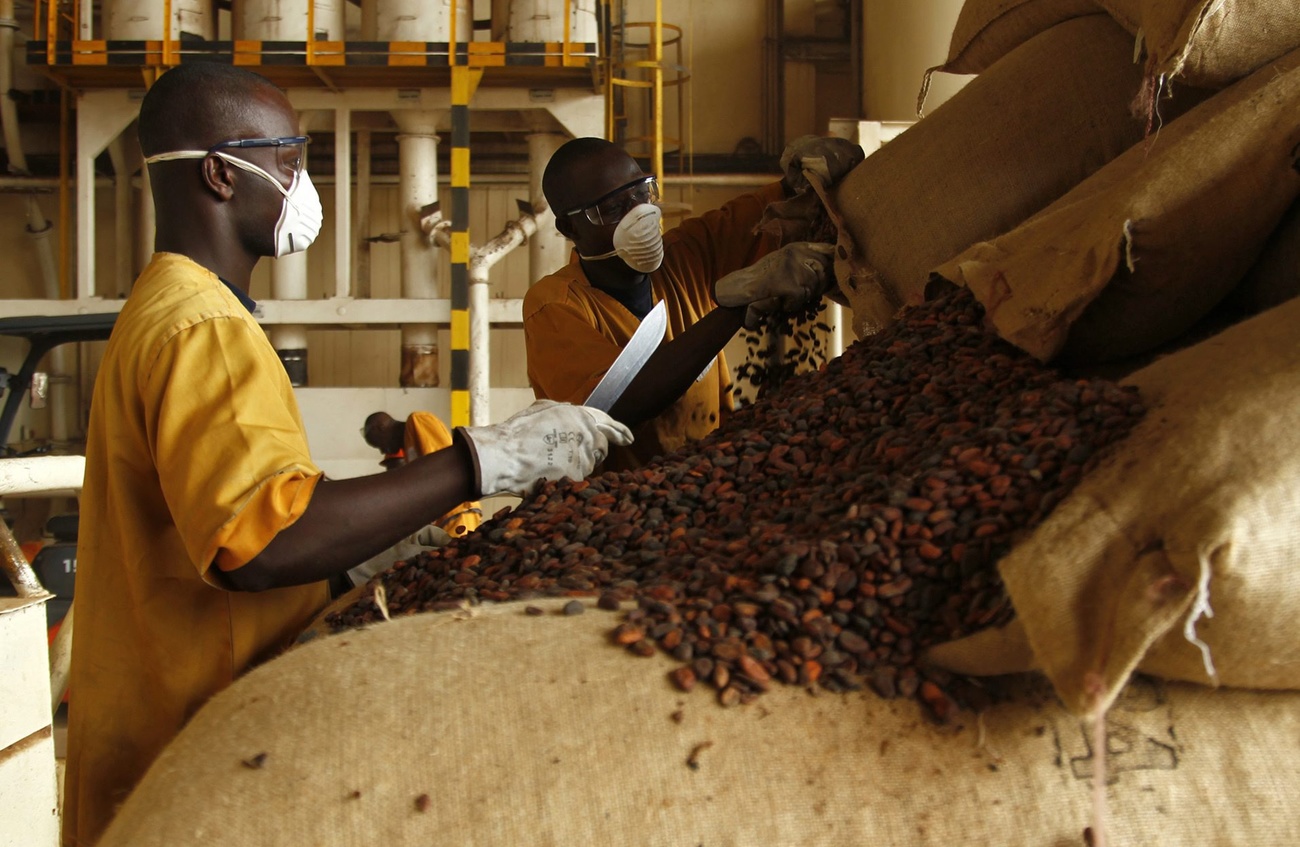
Children work in Swiss chocolate maker Lindt’s supply chain in Ghana

Ghanaian children help produce cocoa for Swiss chocolate manufacturer Lindt & Sprüngli, according to a recent report by Swiss public television, SRF. The company says that combatting child labour is a “top priority”.
Lindt & Sprüngli, which is based in Kilchberg in canton Zurich, has developed a sustainability programmeExternal link for its cocoa farmers. The programme promises to reduce the risk of child labour, address deforestation, and preserve biodiversity.
The reality on the ground, however, is far from perfect, as Swiss public television, SRF, discovered when it investigated cocoa plantations near the town of Tepa in western Ghana.
SRF’s report revealed a number of children working in Lindt & Sprüngli’s supply chain. In the village of Mfenibu, for example, six-year-old Kennedy and his eight-year-old brother Ebenezer were collecting and carrying cocoa pods.
“I have to rely on the children,” said their widowed grandmother, Lucy Ajubie, a cocoa farmer. She explained that she was in debt.
Lindt & Sprüngli declined to comment on camera. In a written statement it explained that the systemic factors leading to child labour are very difficult to influence. The company stressed that “fighting child labour requires efforts on the part of governments, non-governmental organisations, companies, local institutions, schools, and farmers”.
Insufficient monitoring
Lindt & Sprüngli sources cocoa from roughly 80,000 farmers in Ghana, making it one of the leading cocoa buyers in the country.
In 2016, the chocolate manufacturer introduced measures designed to prevent child labour: it makes unannounced visits to its cocoa farmers. Over the course of 8,491 surprise visits in 2021, the company discovered 87 child workers. Ghanaian journalist Kwetey Nartey feels the number of cases reported by Lindt – roughly one per 100 visits – is “laughable”. He believes “the monitoring carried out by the chocolate companies is insufficient”.
Some chocolate makers do, however, report a much higher incidence of child labour. In its most recent inspection, Swiss chocolate giant Barry Callebaut, the world’s top producer of cocoa products, recorded 53,839 children working for roughly 250,000 farmers in West Africa.

More
Is child labour really that bad?
Lindt & Sprüngli accounted for its numbers by explaining that “the methods used to identify child labour differ among chocolate manufacturers”. The company added that it is “constantly trying to improve [its] identification system”.
Prevention programme
To reduce the risk of child labour, Lindt & Sprüngli created its sustainability programme – the “Farming Program” – to support producers. SRF’s investigation showed, however, that the company has neither a branch office nor employees on site in Ghana.

More
West Africa wants more of Europe’s chocolate pie
Instead, the chocolate manufacturer has outsourced its farming programme to ECOM, a Swiss raw-materials group and one of the world’s largest cocoa traders. ECOM is Lindt & Sprüngli’s official supplier of Ghanaian cocoa beans. Lindt responded that it is nonetheless fully engaged: “We constantly support and oversee the implementation of the Farming Program.”
Child labour is a problem for many chocolate companies, not just for Lindt & Sprüngli. According to a University of Chicago studyExternal link, just over half of Ghana’s cocoa-producing households include working children.

More
Cocoa factory slow-down spells trouble for chocolate industry
Adapted from French by Katherine Bidwell/gw

In compliance with the JTI standards
More: SWI swissinfo.ch certified by the Journalism Trust Initiative
















![The four-metre-long painting "Sonntag der Bergbauern" [Sunday of the Mountain Farmers, 1923-24/26] had to be removed by a crane from the German Chancellery in Berlin for the exhibition in Bern.](https://www.swissinfo.ch/content/wp-content/uploads/sites/13/2025/12/01_Pressebild_KirchnerxKirchner.jpg?ver=a45b19f3)










You can find an overview of ongoing debates with our journalists here . Please join us!
If you want to start a conversation about a topic raised in this article or want to report factual errors, email us at english@swissinfo.ch.